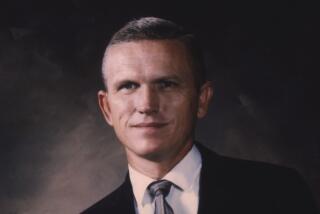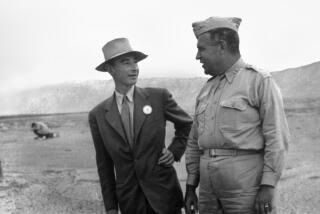U.S. Weighed A-Blast on Moon in 1950s
- Share via
WASHINGTON — The United States considered detonating an atom bomb on the moon during the late 1950s as a demonstration of the nation’s Cold War might, a Chicago physicist says.
The secret project, innocuously titled “A Study of Lunar Research Flights,” was never carried out. But its planning included calculations by the astronomer Carl Sagan--then a young graduate student--of the behavior of the dust and gas generated by the blast.
Viewing the nuclear flash from Earth might have intimidated the Soviet Union and boosted Americans’ confidence after the launch of Sputnik, physicist Leonard Reiffel said Wednesday. He directed the inquiry at the former Armour Research Foundation, now part of the Illinois Institute of Technology.
“Now it seems ridiculous and unthinkable,” said Reiffel, 72, who later served as a deputy director at NASA during the Apollo program. “But things were remarkably tense back then.”
Sagan went on to become a worldwide celebrity for popularizing science on television. He died in 1996.
Reiffel described the plan in a letter in the May 4 issue of the scientific journal Nature.
Nature published a review of two new Sagan biographies. The author of one of the books suggested that Sagan breached security in 1959 by revealing the classified project in an application for an academic fellowship. Reiffel concurred that Sagan probably released classified information.
The exchange in the scientific journal inadvertently shines a spotlight on a period when science in the United States was greatly influenced by Cold War politics.
The U.S. space program was sputtering while the Soviet Union had launched Sputnik and a pair of lunar probes.
The Eisenhower administration considered the lunar blast as a way to reassure Americans that the Soviet threat could be countered while demonstrating to the Kremlin that the United States had an effective nuclear deterrent.
Under the scenario, a missile carrying a small nuclear device was to be launched from an undisclosed location and travel 238,000 miles to the moon, where it would be detonated upon impact. The planners decided it would have to be an atom bomb because a hydrogen bomb would have been too heavy for the missile.
Reiffel said the nation’s young space program probably could have carried out the mission by 1959, when the Air Force deployed intercontinental ballistic missiles.
Military officials apparently abandoned the idea because of the danger to people on Earth in case of a failure. The scientists also registered concerns about contaminating the moon with radioactive material, Reiffel said.
The Air Force has declined to comment on the project, pending a review of historical records.
“There was lots of talk on the part of the Air Force about the moon being ‘military high ground,’ ” Reiffel said.
More to Read
Sign up for Essential California
The most important California stories and recommendations in your inbox every morning.
You may occasionally receive promotional content from the Los Angeles Times.













